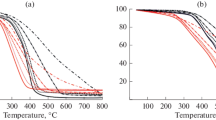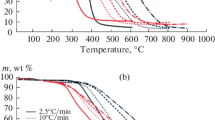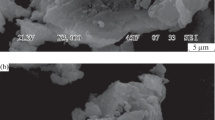Abstract
Thermal analysis was used to study the influence of CaCl2 and urea as possible chemical additives inhibiting coal oxidation process at temperatures 100–300 °C. Weight increase due to oxygen chemisorption and corresponding amount of evolved heat were evaluated as main indicative parameters. TA experiments with different heating rates enabled determination of effective activation energy E a as a dependence of conversion. In the studied range of temperatures, the interaction of oxygen with (untreated) coal was confirmed rather as a complex process giving effective activation energies changing continuously from 70 kJ mol−1 (at about 100 °C) to ca. 180 kJ mol−1 at temperatures about 250 °C. The similar trend in E a was found when chemical agents were added to the coal. However, while the presence of CaCl2 leads to higher values of the effective activation energies during the whole temperature range, urea causes increase in E a only at temperatures below 200 °C. Exceeding the temperature 200 °C, the presence of urea in the coal induces decrease in activation energy of the oxidation process indicating rather catalysing than inhibiting action on coal oxidation. Thus, CaCl2 can only be recommended as a ‘real’ inhibitor affecting interaction of coal with oxygen at temperatures up to 300 °C.




Similar content being viewed by others

References
Smith AC, Miron Y, Lazzara CP. Inhibition of spontaneous combustion of coal. Report of investigation–USA Bureau of Mines, RI 9196, 1988.
Watanabe WS, Zhang DK. The effect of inherent and added inorganic matter on low-temperature oxidation reaction of coal. Fuel Process Technol. 2001;74:145–60.
Saranchuk VI, et al. Oxidation and self-heating of the coal. Kiev: Naukova Dumka; 1994. (in Russian).
Singh AK, Sahay N, Ahmad I, Mondal S. Role of inorganic compounds as inhibitor in diminishing self-heating phenomena of Indian coal. J Mines Metals Fuels. 2002;50:356–9.
Taraba B, Peter R, Slovák V. Calorimetric investigation of chemical additives affecting oxidation of coal at low temperatures. Fuel Process Technol. 2011;92:712–5.
Mohalik NK, Panigrahi DC, Singh VK. Application of thermal analysis techniques to assess proneness of coal to spontaneous heating. J Therm Anal Calorim. 2009;98:507–19.
Kok MV, Pokol G, Keskin C, et al. Combustion characteristics of lignite and oil shale samples by thermal analysis techniques. J Therm Anal Calorim. 2004;76:247–54.
Slovák V, Taraba B. Effect of experimental conditions on parameters derived from TG-DSC measurements of low-temperature oxidation of coal. J Therm Anal Calorim. 2010;101:641–6.
Akahira T, Sunose T. Method of determining activation deterioration constant of electrical insulating materials. Res Rep Chiba Inst Technol (Sci Technol). 1971;16:22–31.
Vyazovkin SV, Lesnikovich AI. An approach to the solution of the inverse kinetic problem in the case of complex processes: Part 1. Methods employing a series of thermoanalytical curves. Thermochim Acta. 1990;165:273–80.
Sujanti W, Zhang DK. A laboratory study of spontaneous combustion of coal: the influence of inorganic matter and reactor size. Fuel. 1999;78:549–56.
Liotta R, Brons G, Isaacs J. Oxidative weathering of Illinois no. 6 coal. Fuel. 1983;62:781–91.
Calemma V, Iwanski P, Rausa R, Girardi E. Changes in coal structure accompanying the formation of regenerated humic acids during air oxidation. Fuel. 1994;73:700–7.
Acknowledgements
The article has been done in connection with the project Institute of Environmental Technologies, Reg. No. CZ.1.05/2.1.00/03.0100 supported by Research and Development for Innovations Operational Programme financed by Structural Funds of European Union and from the means of state budget of the Czech Republic.
Author information
Authors and Affiliations
Corresponding author
Rights and permissions
About this article
Cite this article
Slovák, V., Taraba, B. Urea and CaCl2 as inhibitors of coal low-temperature oxidation. J Therm Anal Calorim 110, 363–367 (2012). https://doi.org/10.1007/s10973-012-2482-4
Published:
Issue Date:
DOI: https://doi.org/10.1007/s10973-012-2482-4



